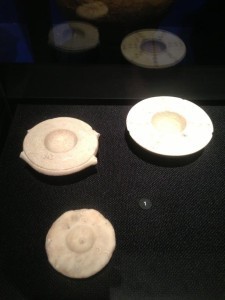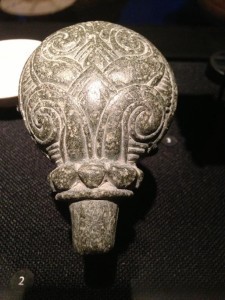Marci Jefferson's Blog, page 2
September 24, 2013
Can’t judge a book by it’s cover…or size
I love writing. Love it. The only activity I love more is researching the history behind what I am writing about. I also love a new project. The kind of idea that gets under your skin and keeps you up at night and has you running lines of dialogue through your head while you’re trying to make dinner. That’s me right now.
I get so excited about a new project that I tend to buy lots and lots of research books. The research is so fun! And these last few weeks I’ve been buying a lot of books. I’ve also been checking out scads of out-of-print research books from the library. Sometimes I find a library book that is such a valuable resource I have to find and buy my own copy. That’s what happened with the big black book pictured below. It is simply loaded with information that I must have on hand at all times! But do you see the little red book on top of it? That is a different edition of the same book that arrived in the mail today. At first I was upset with myself for ordering the wrong thing…but it is exactly the same! Astonishing, isn’t it? I guess you can’t judge a book by it’s cover…or size.

different editions of the same book
August 30, 2013
Kate Quinn Talks Serpents, Pearls, and Odd Recipes for Glorious Renaissance Hair
I’m delighted to host one of my most favorite people today! Kate Quinn is here to talk about her latest novel and dish on Renaissance hair care…
About Kate
Kate Quinn is a native of southern California. She attended Boston University, where she earned a Bachelor’s and Master’s degree in Classical Voice. A lifelong history buff, she has written three novels set in ancient Rome: “Mistress of Rome,” “Daughters of Rome,” and “Empress of the Seven Hills,” all of which have been translated into multiple languages.
Kate made the jump from ancient Rome to Renaissance Italy for her fourth and fifth novels, “The Serpent and the Pearl” and “The Lion and the Rose,” detailing the early years of the Borgia clan. She also has succumbed to the blogging bug, and keeps a blog filled with trivia, pet peeves, and interesting facts about historical fiction. She and her husband now live in Maryland with a small black dog named Caesar, and her interests include opera, action movies, cooking, and the Boston Red Sox.
The official blurb for THE SERPENT AND THE PEARL:
Rome, 1492. The Holy City is drenched with blood and riddled with secrets. A pope lies dying and the throne of God is left vacant, a prize awarded only to the most virtuous – or the most ruthless. The Borgia family begins its legendary rise, chronicled by an innocent girl who finds herself drawn into their dangerous web . . .
Now Kate, give us your quick-drop on THE SERPENT AND THE PEARL…
Take a vivacious blonde with floor-length hair, add a cynical dwarf on the hunt for a serial killer, toss in one fiery cook with a dangerous past, then stir to a boil, light on fire, and serve for a hell of a read!
Why the switch from ancient Rome to Rome under Borgia rule?
Because I was starting to have daydreams about writing a book where I never, not once, had to type the word t-o-g-a. I love ancient Rome, but I needed a vacation! And the Borgias grabbed me as soon as I started reading about them. That whole era is just saturated with artistic and scientific advancements side by side with bloody mayhem, and the Borgias are the poster children for all that gorgeous Renaissance chaos.
You say your culinary husband inspired dishes in the Serpent and the Pearl, and that his traits appeared in the hero of Mistress of Rome. Can I borrow him? In what other ways does he influence your work?
My Navy sailor husband probably shows up the most clearly in my last book, “Empress of the Seven Hills,” which features another tall freckled left-handed military man who doesn’t suffer fools even when they’re superior officers! As for “The Serpent and the Pearl,” one of my two heroines is inspired directly by my husband’s fiery Sicilian grandmother, the one who taught him to cook so well. To this day he can’t break pasta into a pot of water without a wince and a “Sorry, Grandma” because just like my Renaissance cook heroine, his grandmother would whack you over the head with a wooden spoon for daring to break pasta instead of folding it. She turned my husband into a fabulous cook; now that “Serpent and the Pearl” is out, he’s having fun cooking his way through all the recipes in it. Who knows, maybe there will be a companion cookbook?
I’m really into the use of cosmetics throughout history. Did you uncover any interesting beauty regimens during your research of the Borgia family?
My second heroine Giulia Farnese was one of the most famous beauties of the Renaissance, especially known for her floor-length hair, so you can bet her beauty routines are meticulous. Some of the Renaissance cosmetics recipes I found are absolutely vile, like a face mask that calls for dove entrails. Others, like a rinse for blondifying hair which was made out of saffron, cinnabar, and sulphur, sound a bit nicer. Renaissance ladies were all mad for fair hair, so a favorite girls-day-out back then was to head up to the rooftop and put on big-brimmed crownless sun hats so you could spread your hair out under the sun to bleach it, but still keep your skin white!
Finally, a discussion on craft. Your sentences are so precise and well paced! Is this a natural gift or do you have to edit a work to death before it’s in such great shape?
Edit, edit, edit. Re-read, curse a little, edit some more. One of my worst habits is that I start unconsciously relying on favorite words or phrases. Almost the last thing I do is to run a Search in my manuscript for the words and phrases I like to overuse: shrug, smile, grin, glare; arms folded across chests; people tilting their heads; etc. But it’s like a Whack-A-Mole game: no sooner do I push down one set of over-used words than another set pops up in its place!
Thank you, Kate! It is always a pleasure! Do I finally have the secrets to your own lovely golden tresses? Is that saffron or cinnabar I smell? I’m headed for the spice aisle right now!
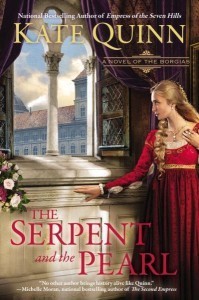
The Serpent and the Pearl by Kate Quinn
~Praise for THE SERPENT AND THE PEARL
“Three compelling characters weave a tangled trajectory through the life and politics of 15th-century Rome. Carmelina’s sharp tongue, Leonello’s caustic wit, and Giulia’s unconditional good humor in the face of danger play off each other beautifully to create another riveting novel from Kate Quinn.”
– Historical Novels Review, August 2013
August 26, 2013
End of Summer Tomato Dish
If you think these look like black cherry tomatoes marinating in white balsamic vinegar and homegrown herbs, you’re right!
Our family goes on vacation every summer, and inevitably my tomato plants wait until I’m gone to go to fruit. But I do love coming home to the tasty bounty! And the fact that I’m actually stirring up this dish in my kitchen is a sure sign that I’ve begun to dig myself out of the post-vacation fall-out. Not only is the laundry done, but school uniforms are bought. Not only are school supplies bought, I’ve already marched the children back to the start of classes. Not only have I cleaned up the house after said children’s summer mess, but the luggage is back in the attic. Not only have I proof-read the first-pass pages of GIRL ON THE GOLDEN COIN, I’m writing a blog post, at last!
The purpose of this post? To announce that I finally drew the winner for my cover reveal giveaway! I’ll be sending one lucky blog commenter a pair of sterling silver pearl drop earrings soon! And since response to my Facebook post announcing the cover reveal was so robust, I drew a second winner from the commenters there! Winners will hear from me this week!
But since it’s tomato season, I’ll also share the simple recipe for this dish!
Marci’s Bruschetta
2 cups diced tomatoes or halved cherry tomatoes
2 tablespoons white balsamic vinegar
2 tablespoons extra virgin olive oil
1 tablespoon chopped fresh basil
2 tablespoons chopped fresh chives
1 chopped garlic clove
kosher salt to taste
I serve this on toast if I’ve used diced tomatoes, but I served these little guys on a bed of cooked quinoa tonight! Enjoy!
July 29, 2013
A Shimmering Cover Reveal for Girl on the Golden Coin
This is a VERY exciting day for me because I get to share something very special with all of YOU! Thanks to the creative and industrious designers at Thomas Dunne Books, I have a cover both striking and elegant enough to be worthy of the woman of my debut novel’s focus. From the movement in her gown to the sheen of her pearls to the gleam of the golden coin stamped with her image, I could not imagine a book cover more suited to Frances Stuart. Take a look…

Girl on the Golden Coin, a Novel of Frances Stuart
My very first novel is about the seventeenth century beauty who rejected three kings and graced England’s coins for generations as the model for Britannia. It will release February 11, 2014 from Thomas Dunne Books / St. Martin’s Press. But I’m in the mood to celebrate this triumphant cover right now! Pre-order before the end of the week and comment on this blog post for a chance to win a pair of sterling-silver pearl-drop earrings like the ones Frances wears on the cover (be prepared to present your receipt).
FIND IT HERE:
MORE ABOUT THE BOOK
Impoverished and exiled to the French countryside after the overthrow of the English Crown, Frances Stuart survives merely by her blood-relation to the Stuart Royals. But in 1660, the Restoration of Stuart Monarchy in England returns her family to favor. Frances discards threadbare gowns and springs to gilded Fontainebleau Palace, where she soon catches King Louis XIV’s eye. But Frances is no ordinary court beauty, she has Stuart secrets to keep and people to protect. The king turns vengeful when she rejects his offer to become his Official Mistress. He banishes her to England with orders to seduce King Charles II and stop a war.
Armed in pearls and silk, Frances maneuvers through the political turbulence of Whitehall Palace, but still can’t afford to stir a scandal. Her tactic to inspire King Charles to greatness captivates him. He believes her love can make him an honest man and even chooses Frances to pose as Britannia for England’s coins. Frances survives the Great Fire, the Great Plague, and the debauchery of the Restoration Court, yet loses her heart to the very king she must control. Until she is forced to choose between love or war.
On the eve of England’s Glorious Revolution, James II forces Frances to decide whether to remain loyal to her Stuart heritage or, like England, make her stand for Liberty. Her portrait as Britannia is minted on every copper coin. There she remains for generations, an enduring symbol of Britain’s independent spirit and her own struggle for freedom.
ADVANCE PRAISE
“In her wonderfully evocative debut, Girl on the Golden Coin, Marci Jefferson recreates the fascinating story of Frances Stuart, whose influence over England’s Charles II became the talk of a nation. As vibrant and delightful as the woman it’s based on, Girl on the Golden Coin is a jewel of a novel!”
—Michelle Moran, New York Times bestselling author of The Second Empress and Madame Tussaud
“Beauty is not always a blessing, as young Frances Stuart finds out when her lovely face pits her between the desires and politics of rival kings Louis XIV and Charles II. Frances makes an appealing heroine, by turns wary and passionate, sophisticated and innocent, as she matures from destitute young pawn to the majestic duchess whose figure would grace Britain’s coins for centuries. Her struggles to support her loved ones, uncover her family secrets, and somehow find a life of her own amid the snake-pit courts of the Sun King and the Merry Monarch make for lively, entertaining reading in this lush Restoration novel by debut author Marci Jefferson.”
—Kate Quinn, New York Times bestselling author of Mistress of Rome
“Girl on the Golden Coin is a fantastic novel. I couldn’t put it down. The plot is fast-paced and compelling, with intriguing characters, lush settings and captivating narrative voice. Jefferson’s debut paints an intriguing portrait of Frances Stuart, a novel worthy of the determined, golden spirit of the woman whose face became the model for Britannia herself.”
—Susan Spann, author of Claws of the Cat
“Girl on the Golden Coin is a sexy, exciting tale featuring vivid characters, rich historical detail, scintillating court intrigue, and a complexly rendered heroine in Frances Stuart, Maid of Honor to the Queen of England, who will capture the reader’s heart — as will the man she loves, that rascal King Charles II.”
– Sherry Jones, author, FOUR SISTERS, ALL QUEENS
July 16, 2013
Comforting Lavender, Sweet Friends
There are few scents that soothe the senses like lavender. Lavender and I have enjoyed a long and comforting affair. I fell in love with it during my childhood when I saw rows of it planted at an old plantation house in Virginia. Oh how it sweetened the air and entranced the bees bobbing from stem to stem! My favorite tea at night is a mixture of homegrown chamomile and lavender, and a few drops of lavender oil in a bath is an easy escape from “crazyeverydayness” (moms will understand that made-up word). Several years ago, a favorite neighbor gave me a 4 inch pot of English Lavender, and that plant has grown to a leggy 4 feet wide. I harvest what I can for tea, and buy extra to create gifts like this…

Marci Jefferson’s Lavender Sachets: three tablespoons of dried lavender buds and five drops of lavender essential oil
But I’m not the only one entranced by lavender’s heady charms. Ancient Roman soldiers supposedly used it to perfume their bathwater. They are the ones likely responsible for importing it in 200 BC to England, where tourists still love to buy bars of lavender soap. Around 40 AD the Greek physician Pedanius Discordes wrote De Materia Medica, and proclaimed lavender to be “like Hyssop, good for griefs in the thorax. It is also mingled profitably with Antidotes.” His botanical wisdom was quoted up through the seventeenth century, when the English followed the example set by the Stuart Royals and used lavender in perfumes. Look for more about that in posts to come!
Personally, one of my favorite uses for lavender is in linen drawer sachets. I belong to a group of lady writers who have become very dear friends over the last year; they comfort through disappointments, cheer through victories. One of them is handy at the pottery wheel, and sent me a delightful tea mug. The only payment she requested was that I pay the shipping cost forward. So I distributed the sachets above to everyone in the group. It was an appropriate gift, I think, to give soothing lavender to my comforting friends.
July 12, 2013
Josephine’s Ruby Lips
My friend Heather Webb’s book design is being revealed today! The novel is BECOMING JOSEPHINE and, appropriately, Josephine and her famous husband Napoleon are featured on the cover. You may remember my post about the popularity of cochineal used to darken lips through the centuries…well just look at Josephine’s juicy red lips here to see it in action!
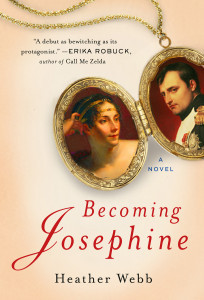
Becoming Josephine
Heather Webb’s debut is a novel about Napoleon’s empress, a woman in search of eternal love and stability, and ultimately her search for self. It releases December 31, 2013 from Plume/Penguin. Stop by Heather’s blog Between the Sheets and leave a comment for a chance to win a $20 gift card to Barnes & Noble or a $20 gift card to Amazon. Pre-order her novel (present a receipt) and win a Josephine hand mirror with a velvet bag.
I think I’ll have to invite Heather Webb for an interview at release!
MORE ABOUT THE BOOK
Rose Tascher sails from her Martinique plantation to Paris to trade her Creole black magic culture for love and adventure. She arrives exultant to follow her dreams of attending Court with Alexandre, her elegant aristocrat and soldier husband. But Alexandre dashes her hopes and abandons her amid the tumult of the French Revolution.
Through her savoir faire, Rose secures her footing in high society, reveling in handsome men and glitzy balls—until the heads of her friends begin to roll.
After narrowly escaping death in the blood-drenched cells of Les Carmes prison, she reinvents herself as Josephine, a socialite of status and power. Yet her youth is fading, and Josephine must choose between a precarious independence and the love of an awkward suitor. Little does she know, he would become the most powerful man of his century- Napoleon Bonaparte.
BECOMING JOSEPHINE is a novel of one woman’s journey to find eternal love and stability, and ultimately to find herself.
ADVANCE PRAISE
Becoming Josephine has already been featured in a Wall Street Journal piece on the popularity of historical fiction featuring the wives of famous men.
“Heather Webb’s epic novel captivates from its opening in a turbulent plantation society in the Caribbean, to the dramatic rise of one of France’s most fascinating women: Josephine Bonaparte. Perfectly balancing history and story, character and setting, detail and pathos, Becoming Josephine marks a debut as bewitching as its protagonist.” –Erika Robuck, author of Hemingway’s Girl
“With vivid characters and rich historical detail, Heather Webb has portrayed in Josephine a true heroine of great heart, admirable strength, and inspiring courage whose quest is that of women everywhere: to find, and claim, oneself.” –Sherry Jones, bestselling author of The Jewel of the Medina
“Josephine’s warmth and complexity comes to vibrant life in this fascinating novel rich with vivid historical detail.”—Teresa Grant, Author of THE PARIS AFFAIR
“Vivid and passionate, Becoming Josephine captures the fiery spirit of the woman who stole Napoleon’s heart and enchanted an empire. –Susan Spann, author of The Shinobi Mysteries
“A fast-paced, riveting journey, Becoming Josephine captures the volatile mood of one of the most intense periods of history—libertine France, Caribbean slave revolts, the French Revolution and the Napoleonic Wars—from the point of a view of one of its key witnesses, Josephine Bonaparte.” –Dana Gynther, author of Crossing on the Paris
“Spellbinding . . . Heather Webb’s novel takes us behind the mask of the Josephine we thought we knew.” –Christy English, author of How to Tame a Willful Wife and To Be Queen
“Enchanting prose takes the reader on an unforgettable journey . . . Captivating young Rose springs from the lush beauty of her family’s sugar plantation in Martinique to shine in the eighteenth century elegance of Parisian salon society. When France is torn by revolution, not even the blood-bathed terror of imprisonment can break her spirit.” –Marci Jefferson, author of Girl on the Gold Coin, Thomas Dunne Books, 2014
FIND IT HERE:
June 26, 2013
Guest Author Susan Spann on Claws of the Cat and Shinobi Hairstyling
Today I’m doing something I hope to do even more in the future; hosting a guest author!
Not just any author, the talented Susan Spann, here to talk about her debut novel The Claws of the Cat, the first in her Shinobi Mysteries series. Why have I ventured out of my comfortable historical-cosmetics zone, you ask? Because Susan is special. We met in San Diego at the Historical Novel Society Conference in 2011, becoming instant friends and later writing group partners. As writers go, she is the real deal. The kind of writer who isn’t comfortable unless she writes every day, the disciplined kind who can focus on nothing but writing until she types “the end,” the talented kind who’s prose is always tight and fast paced. And, if my predictions prove correct, the kind of writer who will end up on bestseller lists everywhere. The book released July 16 and, based on reviews and early sales, she’s already off to a great start!
1) Susan, tell us about Claws of the Cat.
The inspiration for the series came as a single, unexpected thought: “Most ninjas commit murders, but Hiro Hattori solves them.”
Claws of the Cat is the first installment of the Shinobi Mystery Series featuring shinobi (an alternate word for ninja) detective Hiro Hattori and his Portuguese Jesuit sidekick, Father Mateo. Here’s the scoop:
Kyoto, 1565: When a samurai is brutally murdered in a Kyoto teahouse, master ninja Hiro Hattori has no desire to get involved. But the beautiful entertainer accused of the crime enlists the help of Father Mateo, the Portuguese Jesuit priest who Hiro is sworn to protect, leaving the master shinobi with just three days to find the killer and save the girl and the priest from the dead mans vengeful son.
The investigation plunges Hiro and Father Mateo into the dangerous waters of Kyotos floating world, where they quickly learn that everyone from the elusive teahouse owner to the dead man’s dishonored brother has a motive to keep the samurais death a mystery. A rare murder weapon favored by ninja assassins, a female samurai warrior, and a hidden affair leave Hiro with too many suspects and far too little time. Hiro must use his ninja skills in a secret mission designed to reveal the assassins identity and save the Jesuit from execution. But the mission uncovers a host of secrets that threaten not only Father Mateo and the teahouse, but the very future of Japan.
2) You studied Japanese history and culture in college. Can you tell me something about how you became interested in Japanese Studies?
My interest in Japanese culture sprang from a book I never read. My seventh grade history syllabus included a book called Through Japanese Eyes, which we were supposed to study at the end of the second semester. The class ran long, and we never got to read Through Japanese Eyes, but the title haunted me for years, along with the idea that I could study a culture by trying to see “through the eyes” of its own people.
When I started college, I immersed myself in the history, culture, and languages of China and Japan. My studies focused on the Warring States period in China and on medieval Japan – the period when the shoguns “ruled” the country. The more I learned about Japan, the more its dangerous history and vivid culture drew me in. I’m delighted that my novels allow me to share, and expand on, this lifelong fascination.
3) I’m ashamed to admit I know little about Japanese history. But because of research I did on the Portuguese enfanta Catherine of Braganza (a supporting character in my novel Girl on the Golden Coin), I know Portugal was the first western nation able to enter serious trade with Japan. Father Mateo, the Portuguese priest in Claws of the Cat, is apparently ministering in Japan while his merchant buddies do some local business. This is a significant moment in world history, and I suspect a lot is going on behind the scenes that you haven’t elaborated yet. Can you talk about it more without giving away future plot secrets?
The Portuguese first landed Japan in 1543, and Jesuit missionary activities started there in earnest in 1549. Before that, Japan had little contact with the Western world (by choice). 95 Jesuits worked in Japan between 1543 and 1600, making Father Mateo a fictitious member of a small but well-documented group.
The Shogun attempted to expel Christian missionaries from Japan in 1587, and many Japanese warlords tortured and persecuted priests during the later part of the 16th century.
The second half of the 16th century also represented the height of shinobi (ninja) activity in Japan, and a time when the shogunate changed hands with startling frequency. In fact, the second Shinobi Mystery centers around a plot to assassinate Shogun Ashikaga Yoshiteru, who did, in fact, die in June 1565.
Setting my series in a period of social and political upheaval created both a dramatic backdrop and the opportunity to weave exciting historical moments (and people) into the Shinobi novels.
4) Ok, WOW! I’m seeing lots of fodder for future novels and am even more excited for future installments. But you know I like to talk about historical cosmetics on this blog. Ladies might assume a Shinobi Murder Mystery with male protagonists lacks beautifying elements. But there are soft touches that female readers will love. Your penchant for using flowers, the elegance of a female suspect, and, my favorite, Hiro’s hair. I’m nuts about Hiro. Please elaborate on how he cares for and styles that gorgeous hair of his!
During the medieval period, most samurai men and women visited professional hairdressers at least once a week (and sometimes more!). Samurai men wore their hair long, with a shaven pate. The hair on top and at the back of the head was worn in a special folded topknot called chonmage. Although some people could fix the chonmage themselves, samurai who could afford a hairdresser usually had their hair “professionally styled” about once a week.
To prepare the chonmage, the hairdresser brushed and oiled the samurai’s hair, sometimes with expensive scented oils. Then he (hairdressing was an almost exclusively male profession during this era) fastened the hair in a tail on top of the samurai’s head and folded the tail back and forth from front to back. Once the hair was folded neatly, the hairdresser secured the folded hair with a second band (usually made from cloth or leather), creating the distinctive chonmage knot on top of the samurai’s head.
Since the knot would come undone if handled or pushed, samurai often slept with wooden “neck rests” instead of pillows, to preserve the hairstyle as long as possible.
In many ways, medieval Japanese samurai were as fussy about their hair as any modern man – or woman – might be today!
Thank you so much, Marci, for hosting me today! It was great fun to talk with you about Claws of the Cat and medieval Japan!
Thank you, Susan, it has been a pleasure! Readers, check Susan’s website for more information at http://www.susanspann.com/
April 22, 2013
What Nerds do for Spring Break
One thing I’ve noticed during the decade I’ve lived in the Midwest is that everyone here makes a mass exodus to Florida for spring break. Having grown up mostly in the south where a coast was just a hop-skip away and therefore taken for granted, this exodus is interesting to observe. Spring break leaves my home town feeling like a ghost town, and if the local schools didn’t stagger their breaks, I’m afraid hospitals might even be forced to close. Ok I’m exaggerating. But it certainly does make me feel like a serious nerd when my spring break plans center on visiting…a museum.
Yep, this historical fiction author has been known to torture her children with Colonial Williamsburg, Civil War re-enactments, and loooong leisurely walks around Revolutionary War battlegrounds at Yorktown. Hey, cool it, we do fun kid stuff, too (which is why I can advise you to never ever attempt a weekend in Colonial Williamsburg immediately after a week in Orlando for reasons that should’ve been obvious to me).
Last spring break we hit a few museums in Chicago. This year we chose to see a very special exhibit in Cincinnati; the Dead Sea Scrolls. Perhaps the world’s greatest archeological treasure, they were first discovered by a Bedouin goat herder near Qumran in 1947. With six hundred artifacts on display, this was the largest collection from the Holy Land ever to go on tour outside Israel. It included a copy of the ten commandments from about thirty BC, the oldest known, which took my breath away.
Even my kids were impressed. Seriously. My daughter even drew highly accurate pictures of the scrolls in art class when we returned. See…
When I asked her for an exact translation, I received a blank stare. However, for readers who may be interested in what I learned about ancient cosmetics during this museum adventure, I have a treat!
These are Iron Age (seventh-ninth century BC) limestone cosmetic bowls from Hazor, Megiddo, and Arad. Ancient Israelites combined kohl or antimony with fat or resin in these, dipped a metal or ivory wand into the mixture, then used it to line their eyes. Sounds like a lot of work to me.
Decorative palmettes are carved into the underside of this bowl of steatite from the same period.
Keep in mind these are Iron Age tools from the middle east. Stay tuned for more about eye cosmetics from other eras.
April 9, 2013
Back from Break with Big News

Tiramisu Trifle
Spring Break 2013 started with a Big Easter Bang and ended with Big Book News. Not much beats a family gathering with lots of delicious food. And what does a historical fiction author take to Easter potluck? Dessert with a history stretching back to seventeenth century Italy; a Tiramisu Trifle! As part of the This Writer’s Life category on my blog, I’m posting the recipe today. I promise it’s easy, because This Writer has kids and a nursing career and a house and there are just limits to what one woman can accomplish in a day!
And the Big Book News? Well, my debut novel has a new title! It’s still about the beautiful Royalist exile who rejected three of the seventeenth century’s most illustrious kings. But she also graced England’s coins for generations as the model for Britannia, which is why I’m proud to announce the new title here for the first time …
Girl on the Golden Coin,
a Novel of Frances Stuart
Now bear with me while I attempt to scrub out all mentions of the old title in previous posts. And update Twitter, Goodreads, Facebook, my website, third cousins, and my mail carrier. Whew! All this excitement calls for celebration with another Tiramisu Trifle!
Marci’s Tiramisu Trifle
Ingredients:
packaged lady fingers (enough for 3 layers in your trifle dish)
two 8 ounce packages mascarpone cheese
two cups heavy cream
one cup sugar
one cup espresso
one or two cups semi-sweet or milk chocolate chips for chocolate curls
Instructions:
Layer the bottom of your trifle dish with lady fingers (I halved mine to get the edges closer to the curve of the dish). Brush espresso over the lady fingers (or use a turkey baster – the spongy cookies absorb liquid well). Stir half of the sugar and mascarpone cheese in a bowl. In a separate, chilled bowl, whisk heavy cream and the other half of the sugar together until stiff peaks form. Fold the cheese mixture into the cream mixture. Proceed to layer this mixture with the lady fingers (adjust according to the size of your dish, mine held three layers of each). Don’t forget to brush each layer of lady fingers with espresso. End with a cream layer and top with chocolate curls. Refrigerate until time to serve. Enjoy!
To make chocolate curls:
Melt chocolate chips in the microwave in 30 second intervals. Spread into a thin layer on a cookie sheet and allow to harden. Use a metal spatula to scrape the edges of the chocolate away from you to form curls (this takes some practice, but even if it just flakes it will be pretty on top of the cream).
Historical cosmetics lovers, have no fear. My spring break travels took me to a wonderful museum exhibit in Cincinnati that I’ll share with you soon. Photos of ancient cosmetic containers may even be included!
March 12, 2013
Lips Through the Millennia
A friend recently requested a lipstick recommendation, and I couldn’t name a single one. I’m a lip liner and gloss kind of girl. My technique became popular in the 1970’s, but glossing the lips seems to have its roots in the 1930’s, when black and white film actresses needed to lend contour to their lips.
The lipsticks we know, in retractable tubes, were invented in 1915. Lipstick itself, however, has been around for thousands of years. Archeologists discovered a five thousand year old sample of lip rouge in an Egyptian tomb, and Etruscan women still rouged their lips in the sixth century B.C. In the fourth century, early Christians began their unceasing complaints against cosmetics, including lip paints. Even when Europe was thrust into the Dark Ages, men and women in the thriving Indus Valley enhanced their lips with betel.
Ladies in the Middle Ages went for a pale look, and if lips were rouged it was lightly. They used plant matter and minerals. The colorful Queen Elizabeth I’s lips were painted “rubie red.” And by the time James I united Scotland and England as the first Stuart Monarch, cosmetics were more widespread.
The primary lip colorant in use from then into the Restoration Period, and used in my upcoming novel, was known as Spanish Red. The Spanish created this with cochineal insects imported from the Americas. It came on paper and was applied moistened with water or dry with a cloth.
This is an image of just how those prized cochineal bugs were collected.
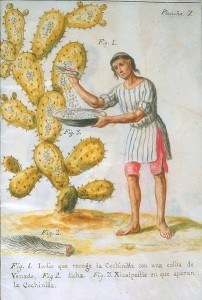
Indian Collecting Cochineal with a Deer tail
In 1740 an alternate became available when a recipe for Red Pomatum for the Lips was published. It called for melted white wax, ox marrow, white pomatum, and a dram of alkanet stirred in until the concoction acquired a red color. I don’t know about you, but I’ll stick to my handy tube of lip gloss!



